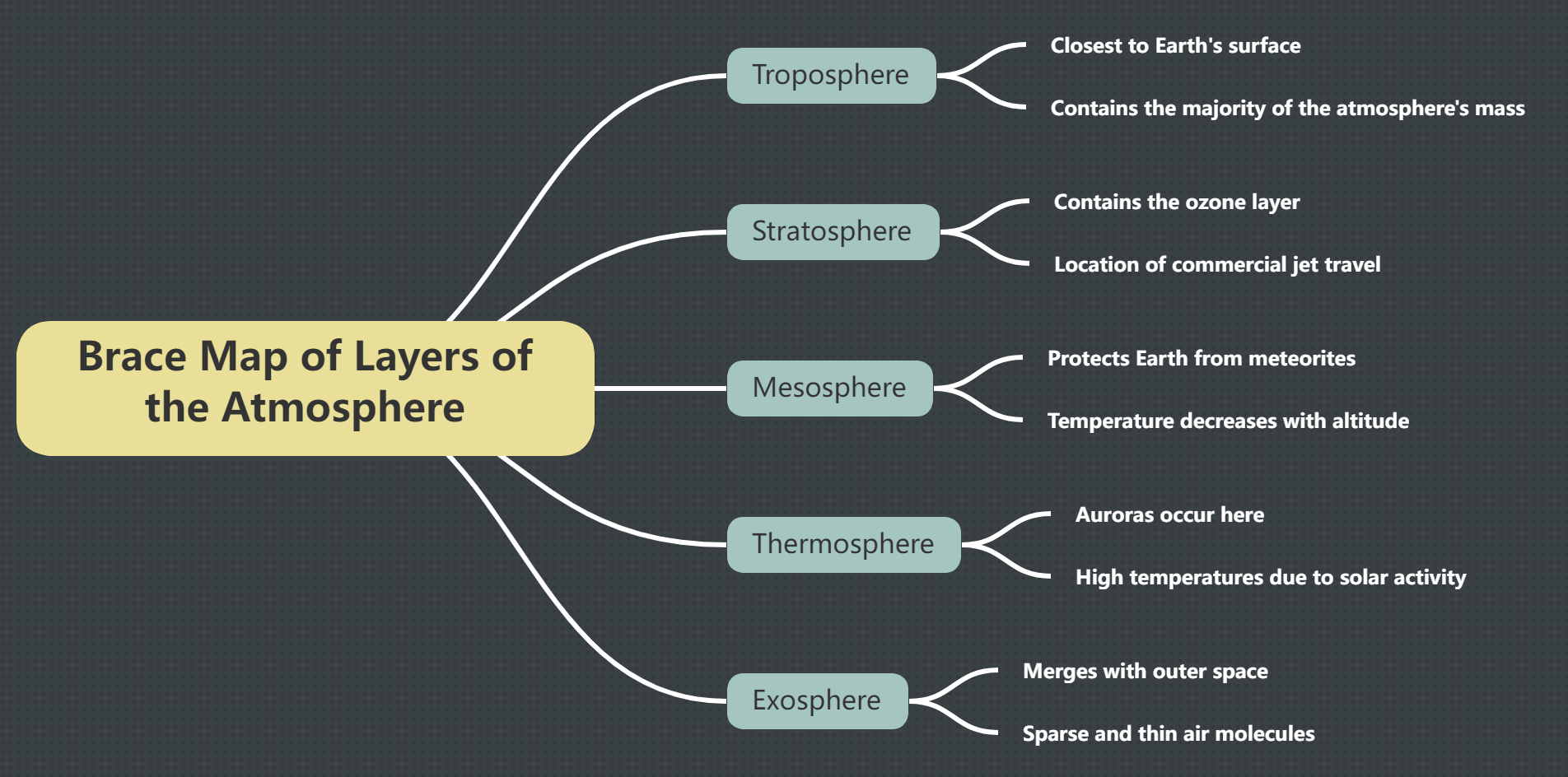
Composition of Atmosphere
The Brace Map of Layers of the Atmosphere provides a focused exploration of the Earth’s atmospheric structure, detailing the characteristics and unique features of each layer. The mind map is organized into five main sections: Troposphere, Stratosphere, Mesosphere, Thermosphere, and Exosphere. Beginning with the Troposphere, the map highlights its proximity to Earth’s surface and its significance as the layer containing the majority of the atmosphere’s mass. Moving upward, the Stratosphere is identified as the home of the ozone layer, crucial for shielding against harmful ultraviolet radiation, and a key region for commercial jet travel. The Mesosphere, situated above, serves a protective role against meteorites and experiences a decrease in temperature with increasing altitude. Advancing further, the Thermosphere, characterized by high temperatures due to solar activity, is where mesmerizing auroras occur. Finally, the Exosphere, the outermost layer, seamlessly merges with outer space, featuring sparse and thin air molecules. This Brace Map offers a concise and visually engaging overview of the Earth’s atmospheric layers, providing valuable insights into their distinct characteristics and functions.
Atmosphere and Climate Effect
The atmosphere plays a pivotal role in shaping Earth’s climate through its interactions with solar radiation and greenhouse gases. Solar radiation penetrates the atmosphere, with the troposphere absorbing and re-radiating a significant portion. Greenhouse gases, such as carbon dioxide and water vapor, trap some of this outgoing radiation, creating the greenhouse effect. While essential for maintaining a habitable temperature on Earth, human activities, particularly the burning of fossil fuels, have led to an increase in greenhouse gas concentrations, intensifying the greenhouse effect and contributing to global warming. This altered climate manifests in various ways, including more frequent and severe weather events, shifts in precipitation patterns, and rising sea levels. Understanding the intricate relationship between the atmosphere and climate is crucial for addressing environmental challenges, mitigating the impacts of climate change, and fostering sustainable practices to preserve the health of our planet.
Start Creating Brace Map
A Brace Map is a visual tool used for hierarchical organization, breaking down complex topics into manageable and interconnected components. In the context of the Earth’s atmosphere, a Brace Map proves exceptionally useful for presenting the layers of the atmosphere in a structured and comprehensible manner. The hierarchical structure of the Brace Map allows for the systematic arrangement of information, starting with the Troposphere at the foundational level and progressing upward through the Stratosphere, Mesosphere, Thermosphere, and Exosphere. This format enables a clear depiction of the distinct characteristics and functions of each atmospheric layer, fostering a better understanding of Earth’s atmospheric structure. To enhance the creation of such insightful Brace Maps, Visual Paradigm Smart Board stands out as an excellent tool. With its user-friendly interface and versatile features, Visual Paradigm Smart Board empowers users to effortlessly construct and customize Brace Maps, providing an efficient and engaging platform for visualizing complex topics like the layers of the atmosphere.